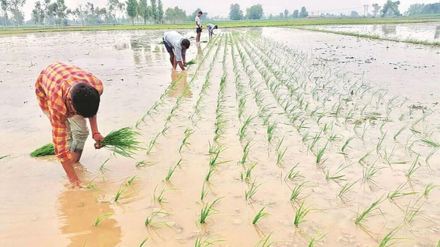The deficit in paddy sowing has declined in the last three weeks because of revival of monsoon rains in parts of key growing regions of Uttar Pradesh, Bihar and West Bengal.
As per the data released by the agriculture ministry on Friday, the deficit in paddy sown regions has reduced to 5.6% against the same period last year, while the decline was 12% for the week ended August 12.
Area under paddy in West Bengal, the largest rice-producing state, was down by more than 10.5% on year on Friday while three weeks ago the deficit was 31%.
Paddy sowing has been hit mainly because of severe deficiency in monsoon rainfall against the benchmark in key states — Uttar Pradesh (-44%), Bihar (-38%) West Bengal (-18%) and Jharkhand (-26%).
The paddy acreage has declined by close to a million hectare (mh) in Jharkhand, 0.44 mh in West Bengal, 0.26 mh in Uttar Pradeh and 0.21 mh in Bihar.
Lower paddy sowing has raised concern about rice production for the 2022-23 crop year (July-June) which would decline by 6 – 10 million tonne (mt) less than 2021-22 crop year’s record level of 129 mt, according to trade estimates.
There are also concerns about a possible rise in prices of rice if kharif production declines as the season accounts for around 80% of the country’s rice production.
Overall kharif crops – paddy, pulses, oilseeds, cotton and nutri-cereals etc have been sown in 106.9 mh as on Friday which is decline of 1.2% against 108.2 mh reported a year ago. Officials said that the kharif sowing activities have been largely completed across the country.
Also Read: Monsoon likely to pick up in Sep after weak rains in Aug; Kharif sowing near completion, rural growth recovers
Overall paddy sowing area across the country was reported at 38.3 mh which was 5.6% less than year ago. Average annual area under kharif paddy between 2016-17 – 2020-21 was 39.7 mh.
While oilseeds such as soyabean and groundnut have been sown in 18.8 mh which is marginally less than last year. Pulses have been sown in 4.3% less area than last year.
India imports about 56% of its edible oil requirement while around 15% of domestic pulses consumption is met through imports.
The cotton sowing has been up by 6.8% so far while sugarcane planting has been marginally higher than last year.
According to India Meteorological Department, cumulative monsoon rains between June 1- September 2 was 756 mm which was 6% (above normal level) more than the normal benchmark – long period average (LPA) of 714 mm.
While several regions in southern, central and north-western India have witnessed water logging and flood-like situations, deficient rainfall in Uttar Pradesh, West Bengal, Bihar and Jharkhand had impacted sowing, especially of paddy, officials said. Many farmers in the eastern regions have sown short duration varieties of paddy because of delay in monsoon rains.
“We can assess the impact of imbalance in rainfall pattern on kharif crops yield only by the end of the month,” an official told FE. Agriculture ministry will release the first advance estimate of kharif crops for the 2022-23 crop year (July-June) this month.
The government earlier this week had set a marginally higher target of 51.8 million tonne (mt) of kharif rice procurement for 2022-23 season (October-September) by the Food Corporation of India and state government agencies against the actual procurement in previous year despite the possibility of drop in output because of lower paddy sowing.
